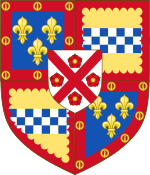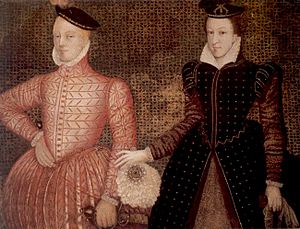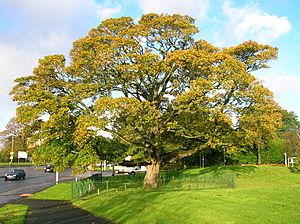Henry Stuart, Lord Darnley facts for kids
Quick facts for kids Henry Stuart |
|
|---|---|
| Duke of Albany Earl of Ross Lord Darnley |
|
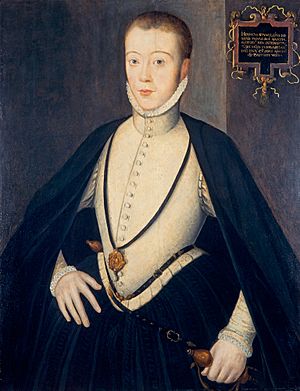
Lord Darnley in his late teens, by an unknown artist. National Galleries of Scotland.
|
|
| King consort of Scotland | |
| Tenure | 29 July 1565 – 10 February 1567 |
| Born | 1546 Temple Newsam, Yorkshire, England |
| Died | 10 February 1567 (aged 20) Kirk o' Field, Edinburgh, Scotland |
| Burial | 14 February 1567 Holyrood Abbey |
| Spouse | |
| Issue | James VI and I |
| House | Stuart |
| Father | Matthew Stewart, 4th Earl of Lennox |
| Mother | Lady Margaret Douglas |
| Religion | Catholicism |
Henry Stuart, Lord Darnley (born 1546 – died 10 February 1567) was an English nobleman. He became the second husband of Mary, Queen of Scots. He was also the father of James VI of Scotland and I of England.
Because of his parents, Henry had claims to both the Scottish and English thrones. After his marriage in 1565, he became the king consort of Scotland. Sadly, less than a year after his son was born, Darnley was killed in 1567. Many people at the time called him simply Lord Darnley. This was his title as the future Earl of Lennox.
Contents
- Who Was Henry Stuart, Lord Darnley?
- Darnley's Early Life and Education
- The Fight for the Throne
- Marriage to Mary, Queen of Scots
- Challenges in Their Marriage
- Birth of Their Son
- Darnley's Death
- What Happened After Darnley's Death?
- Darnley's Burial and Missing Remains
- Honours
- Poetry and The Bannatyne Manuscript
- See also
Who Was Henry Stuart, Lord Darnley?
Henry Stuart, Lord Darnley, was the second but oldest living son of Matthew Stewart, 4th Earl of Lennox. His mother was Lady Margaret Douglas. His mother's parents were Archibald Douglas, 6th Earl of Angus, and Queen Margaret Tudor. Queen Margaret was the daughter of King Henry VII of England. She was also the widow of King James IV of Scotland. These family ties gave Darnley a claim to the English throne.
Darnley's Early Life and Education
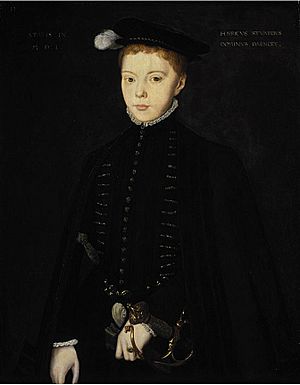
Henry Stuart, Lord Darnley, was born in 1546 at Temple Newsam, Leeds, England. He was a great-great-great-grandson of James II of Scotland. He was also a great-grandson of Henry VII of England. This meant he could potentially claim both the Scottish and English crowns.
In 1545, his father, Matthew Stewart, 4th Earl of Lennox, was found guilty of treason in Scotland. This happened because he sided with the English during a conflict. His father then lived in England for 22 years. He returned to Scotland in 1564. Darnley's mother, Margaret Douglas, had left Scotland in 1528.
Darnley had several teachers. One was the Scottish scholar John Elder. Elder believed that England and Scotland should unite. He thought this could happen if Mary, Queen of Scots, married Prince Edward. Henry was known to be strong and good at sports. He was skilled in riding horses and using weapons. He also loved hunting.
The Fight for the Throne
There was a big political challenge in England. The Lennox family had ambitions for the throne. Matthew Stewart, Darnley's father, was third in line to the Scottish throne. His mother, Margaret Douglas, was a niece of Henry VIII. This made her a possible successor to the English throne if Queen Elizabeth died.
The Lennox family were Roman Catholics. This worried English Protestants. Queen Elizabeth was Protestant. Many Catholics wanted the Catholic Mary, Queen of Scots, to be queen. They did not see Elizabeth as the rightful queen. Darnley, as a male descendant of Henry VII, was also a contender for the English throne. All these family connections led to many secret plans and power struggles.
In 1559, Darnley was sent to the French court. He went to congratulate Mary, Queen of Scots, and her husband, Francis II of France. Darnley's uncle hoped Mary would restore his father's Scottish lands. Darnley's family also hinted that he had a strong claim to the English throne.
English spies watched Darnley and his family closely. They worried that Catholics might try to make Darnley king if Elizabeth died. In 1562, a Catholic spy was caught. His actions led to the arrest of the Lennox family. The spy admitted he was trying to arrange a marriage between Mary, Queen of Scots, and Darnley. He said Darnley's Catholic faith would help him. The Lennox family was released in 1563. Soon after, Darnley and his mother were often seen at Queen Elizabeth's court.
Marriage to Mary, Queen of Scots
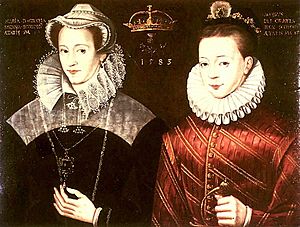
On 3 February 1565, Darnley left London for Edinburgh. On 17 February, he met Mary at Wemyss Castle. People said Mary thought he was a very handsome and well-built man. Darnley soon began spending all his time with Mary.
Darnley and Mary were half-first cousins. This was because their grandmother, Margaret Tudor, had married twice. This connection meant both Mary and Darnley were high in line for the English throne. Darnley was also a descendant of a Scottish king. This put him in line for the Scottish throne too.
Before the wedding, Darnley was made a knight. He also became Lord of Ardmanoch and Earl of Ross on 15 May 1565. England's Privy council was worried about this marriage. They debated the dangers on 4 June. Queen Elizabeth demanded Darnley return to England.
On 22 July, Darnley became Duke of Albany. The marriage was announced in the church. On 28 July 1565, it was declared that Scotland would be ruled by both the king and queen. This made Darnley king and gave him equal power with Mary. Coins were even made with both their names.
The wedding happened on 29 July 1565, following Catholic traditions. It took place in Mary's private chapel. Darnley had been raised Catholic but was also influenced by Protestantism. He chose not to attend the Catholic Mass after the wedding.
Challenges in Their Marriage
Soon after their marriage, Mary noticed Darnley's flaws. He was vain, arrogant, and unreliable. These traits caused problems for the country. Darnley was not popular with other nobles. He also had a tendency to be violent. Mary refused to give Darnley the Crown Matrimonial. This would have made him king if she died without children.
By August 1565, less than a month after the wedding, Darnley's behavior had upset many. Mary soon became pregnant.
On 9 March 1566, Mary's private secretary, David Rizzio, was killed. This happened in front of Mary, who was six months pregnant. Darnley and some Protestant nobles were involved in this plot. Darnley wanted Mary to give him the Crown Matrimonial. He also made a deal with his allies. He would help them get their lands back if they supported his claim to the Crown Matrimonial.
Mary no longer trusted her husband. Darnley was disgraced in the kingdom. On 20 March, Darnley said he knew nothing about Rizzio's death. However, others said Darnley had started the plot.
Birth of Their Son
Mary and Darnley's son, James, was born on 19 June 1566. He was born at Edinburgh Castle. He would later become King James VI of Scotland and I of England.
After James was born, the royal family's future seemed more secure. However, Darnley and Mary's marriage continued to be difficult. Darnley upset many people who might have supported him. This was because of his unpredictable behavior. He still insisted on getting the Crown Matrimonial. This caused ongoing problems in their marriage.
Their son was baptised Charles James on 17 December 1566. The ceremony was Catholic and held at Stirling Castle. Darnley stayed in his rooms at the castle. He felt he was no longer favored.
Darnley's Death
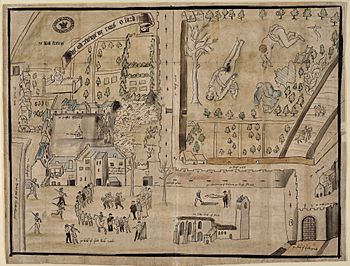
Darnley died eight months after his son James was born. On the night of 9–10 February 1567, his body was found. His valet's body was also found. They were in the garden of Kirk o' Field in Edinburgh. This was where they had been staying.
In the weeks before his death, Darnley was recovering from smallpox. Mary had brought him to Kirk o' Field to get better. She wanted him to rejoin the court. Mary was away at a wedding that night. Around 2 AM, two explosions shook the house. These explosions were caused by gunpowder placed under Darnley's room. Darnley's body was found outside. He was only in his nightshirt. This suggests he had quickly fled his bedchamber.
What Happened After Darnley's Death?
People quickly suspected James Hepburn, 4th Earl of Bothwell. They also suspected his supporters and Mary herself. Bothwell had long been thought to want the throne. Mary had considered ways to remove Darnley. She had discussed divorce, but worried it would make her son illegitimate.
Soon after Darnley's death, Bothwell and Mary left Edinburgh together. Some say Bothwell kidnapped Mary. Others say Mary went willingly. Mary later lost twins she was expecting with Bothwell. This happened while she was held prisoner.
Bothwell was put on trial in Edinburgh and found not guilty. However, suspicions that Mary was involved in Darnley's death caused her to lose support. She lost the Scottish crown. Bothwell fled to other countries. Mary was captured by her enemies. Later, documents called the Casket letters were used as evidence against Mary. They seemed to show she supported the killing. Before his own death in 1581, one noble admitted knowing about the plot. He said Bothwell was a main person involved in Darnley's death.
Mary was held captive for many years. She was later accused of plotting against Queen Elizabeth. She was found guilty and executed.
Darnley's Burial and Missing Remains
Darnley was buried in the Royal Vault at Holyrood Abbey in 1567. Other royals were buried there too. In 1668, the vault was opened by crowds. Later, between 1776 and 1778, the vault was raided. Lord Darnley's skull was stolen.
In 1928, a paper was published about Darnley's skull. It discussed the possibility that his skull was in a museum. In 2016, research was done to identify a skull in a university collection. Scientists compared it to portraits of Darnley. They concluded that the university's skull was not Darnley's. However, a skull that had been in another museum (and later destroyed) was a good match.
Honours
- February 1565: He received the Order of Saint Michael. This was given by King Charles IX of France.
Poetry and The Bannatyne Manuscript
Darnley wrote some poems. These include 'Darnley's Ballet' and 'Gife langour makis men licht'. He might also have written 'Quhair luve is kendlit confortless'. These poems were printed in the Bannatyne Manuscript around 1570.
See also
 In Spanish: Enrique Estuardo, Lord Darnley para niños
In Spanish: Enrique Estuardo, Lord Darnley para niños


